Artists' Books
Artists' Books
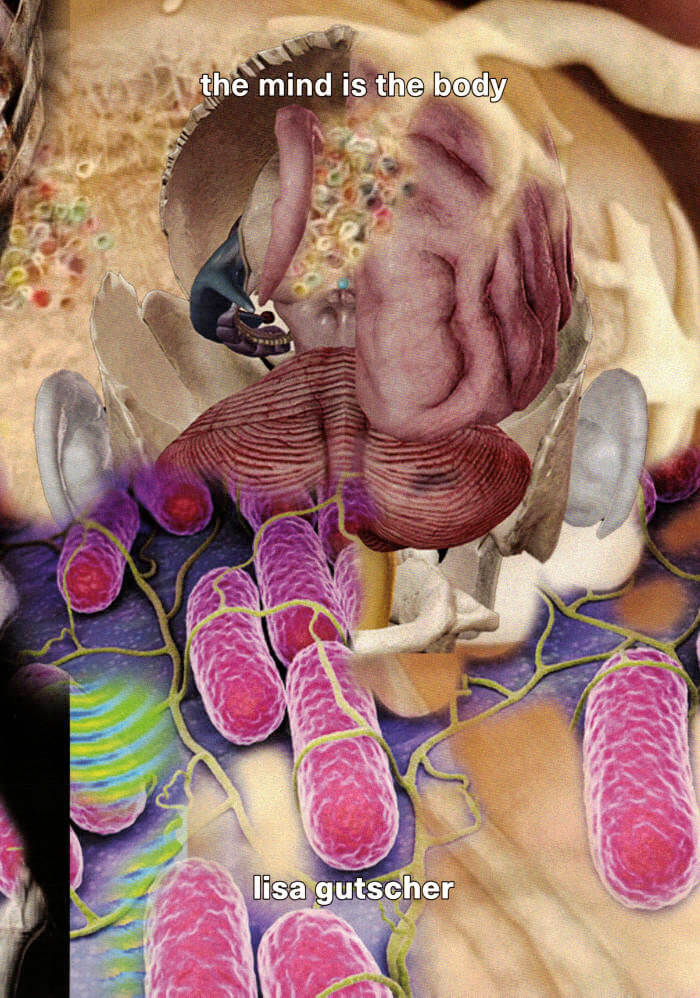
the mind is the body
Printed on thick cardboard, this book throws you right back into the child-like explorer mode we know from when we were young. It illustrates the mindful written words of Lisa Gutscher journey through the inner body based on a large archive from found images, screenshots and other image sources to unfold a whole new world in front of your eyes.

4 Basic Kinds of Lines & Colour
On occasion of the Book as System exhibition, we are thrilled to publish a facsimile reprint of Sol LeWitt’s iconic Four Basic Kinds of Lines & Colour, co-published Printed Matter, Inc. & Primary Information.
Published in 1977 by Lisson Gallery, Studio International, and Paul David Press, the 34 page staple-bound book is an early example of LeWitt’s rigorous, algorithmic process in which a set of rules is run through its permutations to generate corresponding images. First in overview and then in detail, the publication sets down all possible combinations in overlaying four basic lines (vertical, horizontal, right-facing diagonal, left-facing diagonal) followed by a distinct combinatory system of four basic colors (yellow, black, red, blue).
Each spread is composed of these two parallel systems played out one at a time, with escalating line combinations on the left hand side and corresponding color combinations on the right. LeWitt’s Four Basic Kinds of Lines & Colour (1977) followed the publication of Four Basic Kinds of Straight Lines (Studio International, 1969) and Four Basic Colours and their Combinations (Lisson Gallery, 1971), and serves as a kind of synthesis of the two systems described in those earlier volumes.
Published by Printed Matter, Primary Information, 34 pgs, 20 × 20 cm, Softcover

Fleurs du Mal
Charles Baudelaire, Antoine D'Agata
For Charles Baudelaire, the photographic medium is not an art but a technical means of representing reality. As a counterpoint to Baudelaire, Antoine d’Agata reworks his own photographs through digital intervention to return to engraving, as if to go from the pixel to the line of the time. He pushes photography to its limits, discarding the medium to return to the raw. Baudelaire’s texts thus enter into dialogue with photographs that have become engravings through wear and tear and manipulation, where the bodies blend together to give way to the poetry of the body.
The work is based on the original uncensored edition of Baudelaire’s collection accompanied by these engraved prints by d’Agata. Present and past are superimposed. Like a game of transparency that will present the frame of an image on the cover. In this work Fleurs du Mal, Baudelaire is a stroller, a spectator of the world around him, of urban transformations, while d’Agata embodies photography, life and reappropriates the space of the city by the gesture.
Two personalities meet on the occasion of the 200 years of the birth of Charles Baudelaire. Two artists who could have meet each other, debated, confronted each other. For d’Agata, Baudelaire leaves a legacy that must be pushed to extend its own reflection.
The artist intervenes on the edge of Baudelaire’s poems with personal reflections and quotations from his favorite thinkers, descendants of Baudelaire’s thought: Walter Benjamin, Guy Debord or Georges Bataille.
Affixed vertically to the poems, these handwritten interventions assert themselves while leaving the original text its own space. A second sense of reading is thus offered to the reader between Baudelaire’s text and the interpretation given by d’Agata through the words as much as through the engravings.

Hunters Follow Harpy Shadows
Hunters Follow Harpy Shadows is an experimental work featuring a series of poetic writings that explore fantasy narratives of rewritten mythologies. Mixing re-imagined trans Korean folklore, queered Biblical storytelling and pirate lore, the publication is an amalgamation of writing delivered from the lips of the artist as a genderfluid seraphim that has left heaven to tell mortals of the other worlds.
Across twenty-five chapters, Rin Kim’s text recounts the tangled, cosmic history of shapeshifting goddexes intermixed with an otherworldly cast of demis, dryads, wraiths, satyrs, tieflings and sirens. Taking cues from the Old Testament, fantasy storytelling, and the depths of fanfiction forums online, the project alternates between narrative storytelling in the direct mode of epic religious texts and a series of Psalmic interventions spoken in the innermost voice of the gods. Like a series of connected visions, Hunters Follow Harpy Shadows hands down the origin stories of distant worlds — of clashing immortals, species dying out, and deities fading from power. It is both a fantasy saga beset by violence, warfare and blood sacrifice, and a lovers’ song of longing and transcendence.
During the origins of the earth, mortals sacrificed their children to the belly of the depths, to Yawong: god of subservience and singularity…
Central to the project are new images by Oliver Davis, shot on 35mm film, which offer views of a fragmented landscape — jewel-like glimpses of sunlit trees, river stones, and murky underbrush. The lush world seen in these photographs, a version of earth devoid of all humans and figures, provides a quiet space outside of time for staging the mythic struggles of the gods. The book’s typography suggests perhaps an ancient document or illustrated manuscript; the sharp, secret lettering carrying the magic properties of a blade used to split worlds.
Design: Rin Kim
Photography: Oliver Davis
Editing: Olivia Ross
Production: The Uses of Literacy
Cloth-bound hardcover (Feincanvas), with cover tip-in and metallic foil stamping
Rin Kim, born in 1997 in Watertown, New York; is a multi-diciplinary trans chimera, demi, hydra, mutt, graphic designer, filmmaker, alchemist, performance artist, writer, and yong working around non-binary mythologies, ritual storytelling, and fantasy. Their work is a hyperfocused movement of a particular upheaval, an ongoing irruption that re-arranges every assumption of the equivalence of subjectivity and identity.

Responses to Derek Jarman’s Blue
Responses to Derek Jarman's Blue is the third publication in a series of anthologies from Pilot Press seeking contemporary responses to works of art made during the AIDS crisis.
In this third iteration, responses were sought to the 1993 film Blue by the multidisciplinary artist Derek Jarman.
Contributors
In order of appearance
Roelof Bakker
Jared Davis
Becca Albee
Linda Kemp
Ashleigh A. Allen
David Nash
Sam Moore
Anton Stuebner
Gonçalo Lamas
Olivia Laing
Nate Lippens
Jason Lipeles
JP Seabright
Andrew Cummings
Sig Olson
Maria Sledmere
Cleo Henry
Jessie McClaughlin
Lars Meijer
Scott Treleaven
Declan Wiffen
Caitlin Merrett King
Harry Agius
António Manso Preto
Adriana Lazarova
Brooke Palmieri
D Mortimer
Mary Manning
Aaron James Murphy
Printed on 100% recycled paper
Published by Pilot Press, 20 × 15 cm, Softcover, 2022

Bricks from the Kiln — Issue 4: On Translation, Transmission & Transposition
Andrew Walsh‐Lister, Matthew Stuart and 2 more
Bricks from the Kiln is an irregular journal edited by Andrew Lister and Matthew Stuart, sometimes with guest editors, that presents graphic design and typography as disciplines activated by and through other disciplines and lenses such as language, archives, collage, and more. It borrows its title from the glossary notes of Ret Marut’s "Der Ziegelbrenner," which was the ‘size, shape and colour of a brick’, and ran for 13 issues between 1917 and 1921.
The latest installment, "#4: On Translation, Transmission & Transposition," was published as an event (and now) a publication, with events at London College of Communication, Burley Fisher Books & Pig Rock bothy, Socttish National Gallery of Modern Art, and Inga (in November, 2019).
GREENING
Helen Marten
(front / back flaps)
JOY & HAPPINESS, FIDELITY
& INTIMACY IN TRANSLATION
Sophie Collins
(pp.4–13)
PLANETARY TRANSLATION
Don Mee Choi
(pp.15–19)
TRANSLATION AND A LIPOGRAM:
OR, ON FORMS OF AGAIN-WRITING
AND NO- (OR NOT THAT-) WRITING
Kate Briggs
(pp.23–33)
UNHOMING (1 of 4):
FOLLOWING HÖLDERLIN’S ‘HEIMAT’
Phil Baber
(pp.35–47)
SNOW WHITE AND THE WHITE
OF THE HUMAN EYEBALLS
Joyce Dixon
(pp.51–62)
ALTAMIRALTAMIRALTAMIRA
Florian Roithmayr
(pp.65–116)
LEVEL UP, LEVEL DOWN
Jen Calleja
(pp.119–124)
TRANS.MISSION [A.DIALOGUE]:
A JAVASCRIPT FOR THREE VOICES
J.R. Carpenter
(pp.127–134)
THE MECHANISATION OF ART
Edgar Wind
(glosses / annotations / insertions by
Natalie Ferris & Bryony Quinn)
(pp.137–144)
UNHOMING (2 of 4)
Phil Baber
(p.147)
COMMISSION FOR A NOIR MOVIE
B IN THE BAY OF BISCAY
Rebecca Collins
(pp.151–157)
UNHOMING (3 of 4)
Phil Baber
(pp.150–162)
EVERY CONTACT LEAVES A TRACE;
TRANSCRIBING OSTEON
Naomi Pearce
(pp.165–170)
HOW DOES A WORK END?
Karen Di Franco
(pp.173–193)
METONYMY Op.1 & Op.2
James Bulley
(pp.197–201)
AFRIKAN ALPHABETS EXTENDED
Saki Mafundikwa
(pp.204–207)
SUSAN HILLER: 1983
Natalie Ferris
(pp.209–217)
EVERY TELLING HAS A TALING /
EVERY STORY HAS AN ENDING
Matthew Stuart
(pp.220–233)
GRAPHIC PROPRIOCEPTION
James Langdon
(pp.235–254)
UNHOMING (4 of 4)
Phil Baber
(pp.257–263)
TUNNELLING AND AGGREGATING
FOR DESIGN RESEARCH
Bryony Quinn (text) &
Peter Nencini (images)
(pp.265–272)
LET IT PERCOLATE:
A MANIFESTO FOR READING
Sophie Seita
(pp.275–280)
288 pgs, 22.4 × 17 cm, Softcover, 2020

Disparaitre #3
Third issue of Disparaitre, Ethan Assouline's publication. A long promenade in the city looking for new meanings in daily life, work, architecture(...) and new strategies for sabotage and autonomy using sex and poetry.
89 copies, riso printed.
Each back cover is unique and handmade.

SSS – How to imitate the sound of the shore using two hands and a carpet
This publication takes up the issue of mimicking nature and demonstrates how to produce the sound of the sea using two hands and a synthetic carpet.
Artist book by Cevdet Erek
Translated by Ala Younis
Copyedited by Hanan Kassab and Maha Maamoun
Commissioning editors: Maha Maamoun and Ala Younis
Design: Julie Peeters
This publication is an adaptation of Cevdet Erek’s artist book SSS – Shore Scene Soundtrack, Theme and Variations for Carpet, originally published in Istanbul in 2007, by BAS (İstanbul Sanat Aras ̧tırmaları Dernegi), in the context of BENT, Artists’ Books from Turkey, edited by Banu Cennetoğlu and Philippine Hoegen, with design adviser Bülent Erkmen and prepress production assistant Oğuz Yaşargil.
These editions are produced in the context of and with support from Durub Al Tawaya (2014 and 2017); a program curated by Tarek Abou El Fetouh within Abu Dhabi Art.
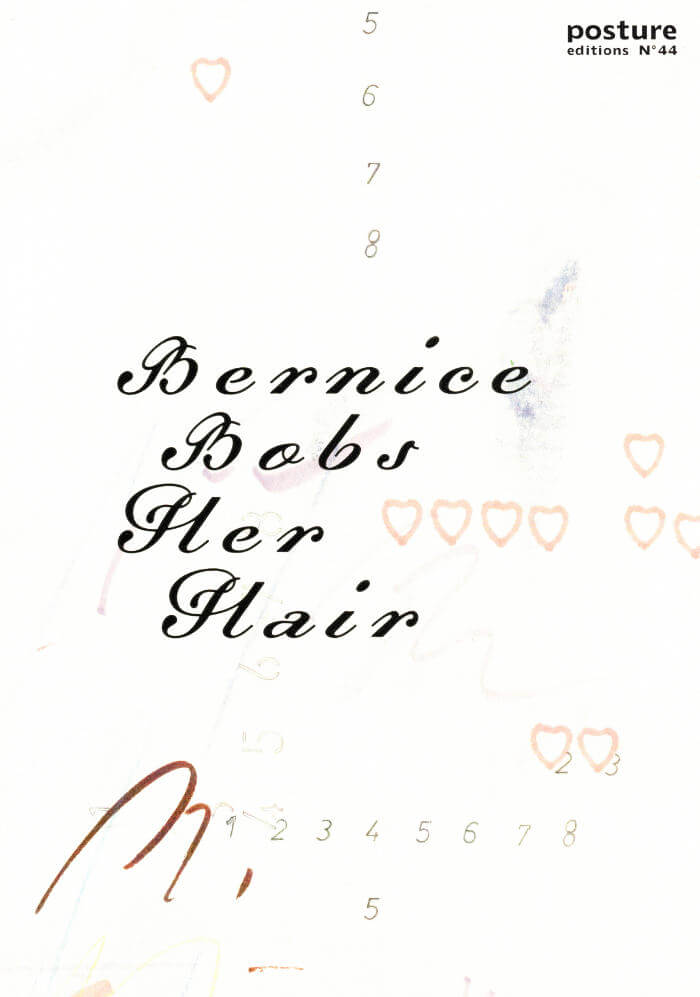
Bernice Bobs Her Hair
‘Bernice Bobs Her Hair’ is a series of layered soft ground etchings, drawings and monotypes. The title is a nod towards a Fitzgerald story about Bernice, who changes her approach to traditional gender roles and youth over a visit to her niece Marjorie. The act of having her hair cut transforms her character into a real flapper and brings her to a new perception of femininity.
Starting from the biased idea and normative use of marginalised graphic procedures as a means of reproduction, the idea of repetition is explored so that iterations become alterations or modifications of the same.
Simultaneously, associations cease to exist and the pregnant B, punning at times, as form and counterform encloses the work.
Fluid figures, painterly gestures and cartoonish scrawls and patterns are subject to a reflection on cuteness, power (-lessness), sexuality and domesticity.
By highlighting marginalised modes of artistic practice and craft-informed techniques, Mabesoone recoups visual languages that have habitually been coded as ultra-feminine and trivial. She questions how these ambiguous and subversive aesthetics can gain authority, and destabilise or resist contemporary realities and dominant cultural constructions.
The book contains poems by Veva Leye and a republication of ‘Trimmings’ by Harryette Mullen.

Rainbow Woman
In her work, Dutch artist Femmy Otten (°1981) explores a very hybrid world of inspiration, ranging from sculptures from Greek antiquity and Italian painters of the quattrocento to American outsider art and contemporary art. She brings all these influences together in a precise yet unfathomable iconography.
The book Rainbow Woman shows mainly recent work, but also revisits a number of older works which Otten has regularly placed in a new context throughout her artistic practice and which have now also been given a new shape in the context of the exhibition in the Warande, Turnhout (01.08-07.11.2021).
Rainbow Woman shows Otten as a versatile painter, sculptor, draughtsman and performer. In ‘Donna Universale’, the art historian Leen Huet places Otten in a tradition of self-confident, female artists that Europe has known since the early Renaissance but who have only sporadically entered the history books as artistically accomplished artists.
The book has many points of contact with the exhibition Rainbow Woman but can also be seen as a sequel to the artist’s book Slow Down Love (2016, nai).

Horaizon
Meggy Rustamova’s (b. 1985) practice explores films and spatial installations, in which she incorporates photographs, essays and audio material; often the work has a performative character. Concerned with the relations between individual and collective memory, language and human behaviour, her works look for ways to translate the current matters and phenomena in the world.
The title of the book and the exhibition, HORAIZON, refers to the phonetic pronunciation of the English word ‘horizon’, the boundary line on which the earth’s surface and the sky seem to touch. The horizon, interpreted as ‘boundary’ or ‘line’, is equally perceptible in language, when reading between the lines, or when travelling between international borders. The contours of the land, trees or buildings, which contrast with the sky, but also the contours of shadows can be observed in many of the images in the exhibition. The works also suggest a longing for what lies behind the horizon and invite the viewer to make an imaginary journey.
On the occasion of Rustamova’s exhibition at the Vrienden v/h S.M.A.K. and the book ‘Horaizon’, the artist created a multiple. The multiple is entitled 1000 km in Vogelvlucht — 621.371 miles at Bird’s Eye View and unfolds as a storyboard, with a collection of sky views and birds the artist has captured over the past two years. From a condor in Arizona to the black-backed gulls in Iceland in the North Atlantic Ocean all through the Sea of Marmara, the book seeks to create a tale that reflects on a person’s daily need for freedom, travel and nature.

Morning Change
Morning Change is a book on movement, location and nomadism in the oeuvre of the Brussels based German artist Heide Hinrichs (b. 1976). It is an invitation to follow different lines that are directed east — east of Kassel, east of Busan, east of Seattle, east of London. The lines are drawn over continents and oceans, against the Earth’s own movement we unconsciously witness with each sunrise. Within the traces of these lines, static objects are put back into motion and they are made to leave their recommended positions of meaning.
The publication brings together three groups of works, developed over different periods of time between 1999 and 2018, exploring the artist’s recurring interest in these topics.
the horse — a story that starts 10 year after the fall of the Iron Curtain, Silent Sisters / Stille Schwestern together with a series of drawings and installations that were conceived in response to DICTEE — a text written by the Korean-American artist Theresa Hak Kyung Cha and On Some of the Birds of Nepal (Parting the Animal Kingdom of the East) — an installation that Hinrichs created in the context of the first Kathmandu Triennale 2017.
An essay by Elizabeth Haines is woven through Morning Change.

Hundred Zundert
Nel Aerts (b. 1987) moves in a freely, intuitive way between different media as painting, drawing, collage, performance and sculpture. Since a few years she focuses more often on the portrait-genre, which she visualises on paper or on wooden panels, with careful attention to the different qualities of each material. As such, she is creating a large collection (family almost) of posing subjects caught between abstract patterns and hard-edged figuration. The figures she portraits refer to both popular culture and her direct, everyday surroundings.
The self-portraits are tragicomic in the sense of the contrasts they evoke. Alternately they are desperate or funny, extra- or introverted, thought- or playful carved from wood or originated as a collage, but they are always introspective and self-relativistic.
In Hundred Zundert, “Nel Aerts evokes a visual rendezvous with Vincent van Gogh and sets the tone for the near one hundred drawings that would be made during her three-month residency at the Van Gogh House in Zundert. Rather than ‘following in the footsteps of Van Gogh’, Aerts is interested in examining the mud and earth around them by (literally) placing herself in the environment of Van Gogh’s youth. The resulting work is characterised by a deceptive interplay between formal simplicity and playfulness which belies a substantial complexity. (…) Nel Aerts’s working process is uncomplicated and free of any pretension: black ball pen (dozens), sheets of white A4 paper (hundreds) and spontaneous, almost naive line work (in seemingly infinite supply) are the building blocks of a story that is nevertheless rich in visual and intimate detail, a story that teeters between seriousness and playfulness, at once both comical and deeply emotive.” From: ‘Portrait of the Artist’, Grete Simkuté, in: Hundred Zundert.

Time and Tide
“In selecting the photographs for this publication, Lisa Spilliaert (b. 1990) was adamant that the image of a sunrise should be among the first in her book. It is, indeed, an emblematic image. For anyone with a camera, such a splendid sunrise is an irresistible trope: a visual motif that simply begs to be captured and fixed on film. In reality, however, the magic of this scene resides in the fleeting, subtle changes in colours and vibrations. This is the dynamic that captivates us.
Photography is usually understood as a technique for ‘stopping’ the flow of time. But as Spilliaert here demonstrates, the impact of photography can also be used to manifest an awareness of time and transience. By accentuating the photographer’s fixed position vis-à-vis the endlessly changing light source, Spilliaert evokes a correlation between stasis and movement, between the cosmic and the mundane. This duality is echoed again in the confrontation of the two equivalent silhouettes: that of the photographer and of his alias or ‘partner’: a life-size technical camera.” — From ‘Time and Tide’ Edwin Carels
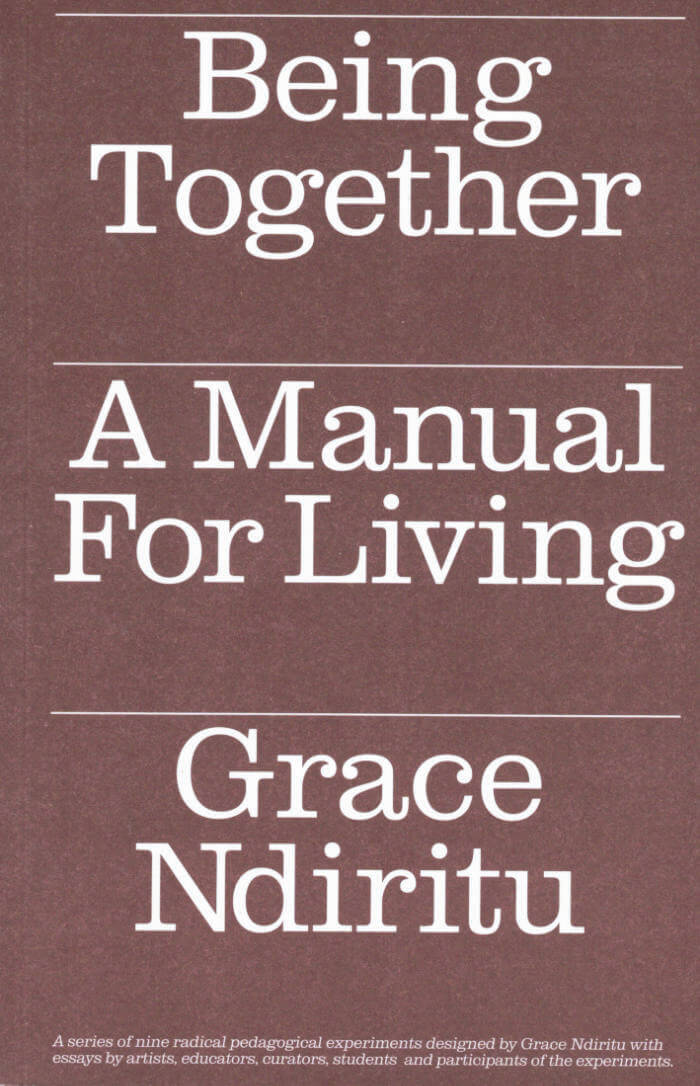
Being Together. A Manual for Living
Being Together: A Manual For Living falls in the lineage of publications such as The Journal of the Society for Education Through Art, which throughout the 1960s provided Britisch art schools a window into experimental education. By contrast, Grace Ndritu's experience in creating radical pedagogies arose from a connected, yet unorthodox system of 'self education'.
In 2012, she decided to spend time living in cities only when necessary. She thus lived in rural, alternative and often spiritual communities, while expanding her research into nomadic lifestyles, and training in esoteric studies, which she began following graduating art school. This research led her to visit Thai and Tibetan Buddhist monasteries, permaculture communities in New Zealand, forest tree dwellers in Argentina, neo-tribal festivals such as Burning Man in Nevada, a Scottish Hare Krishna ashram, and the Findhorn Spiritual Community in Scotland.
Such lifestyles forever transformed her ideas of education and have proven critical for her art, whether conducting social practices or working with students, peers and the general public; some of whose voices appear in this publication. Ndiritu posits, "What does (art) education mean today?" and specifically, "What does an embodied (art) education mean in a time of pandemics and social unrest?". Being Together: A Manual For Living attempts to answer these complex questions.
This book is published on the occasion of Grace Ndiritu's solo show at KRIEG? in Hasselt, Belgium.
Contributors: Philippe Van Cauteren, Pieter Vermeulen, Grace Ndiritu, Rafaela Lopez, Roberto dell’Orco, Jana Haeckel, Katleen Vermeir & Ronny Heiremans, Nathalie Boobis, Shayla Perreault, Edward Ball, Guadalupe Martinez, Stacy Suy, Ezra Fieremans.
Editors: Pieter Vermeulen, Grace Ndiritu
Copy editor: Sue Spaid
Design: Vrints-Kolsteren
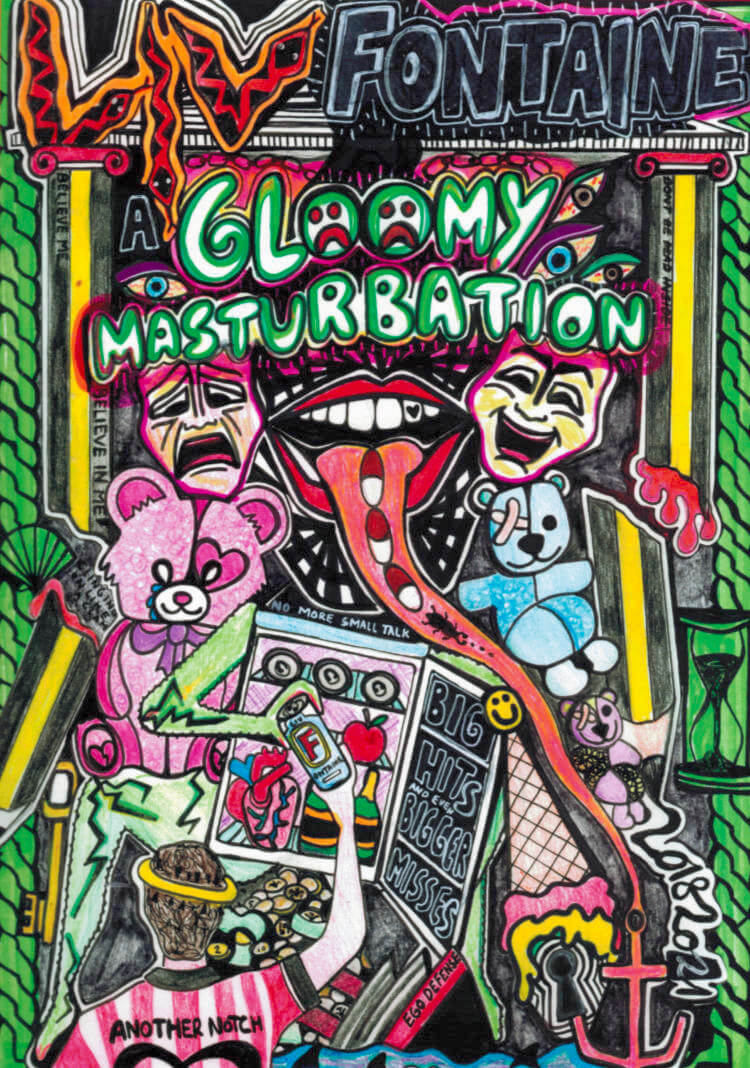
A Gloomy Masturbation
Featuring a selection of drawings from Fontaine’s ongoing project 'A Gloomy Masturbation' this book takes the reader on a trip through the artist's mind. The work functions as part diary, part fantasy, and part information, chronicling her own chronic sickness, fixating on her many failed romantic relationships, and exploring therapeutic theories of the mind and the precarious political situations of our time. Expect tragic comedy, slippery statements, radical honesty, and total teenage angst.

Haiku
Haiku originated in New York City in 1964, when Beat Generation poet Diane di Prima gave West Coast assemblage artist George Herms a series of seasonal poems that would lead him to create a suite of woodcuts illustrating them.
Diane di Prima (1934-2020) was a poet whose writing, activism, and organizing helped define the Beat Generation. She has published more than thirty collections of poetry, as well as memoirs and short stories. She was named Poet Laureate of San Francisco in 2009 and has received the National Poetry Association's Lifetime Service Award.
George Herms (born 1935 in Woodland, California) is an artist/alchemist whose work finding the beautiful in found and discarded objects has led to his being known as one of the founders of the West Coast “assemblage” movement. He has created jazz-inspired sculpture, installations, paintings, drawings, prints, and music all based on an ethics of discovery, rearrangement, and play.

Dan Graham: Theatre
A facsimile of Graham's ultra-rare artist's book documenting early performance works.
Originally published in 1978 and produced here in facsimile form, Theatre is an artist's book documenting seven early performance works by Dan Graham (born 1942) taking place from 1969 to 1977, with notes, transcripts and photo documentation for each performance. These performances catch the artist at a unique moment, as he shifts away from his early media works and towards his hallmark video and written work around underground music and youth culture.
The works in Theatre focus primarily on the psychological and social space between individuals and the roles they serve inside the arena of performance, subverting them by creating conditions by which a performer or audience simultaneously functions as both (creating a type of feedback loop through social transgression). Like most of Graham's work, these performances also serve as a critique of cultural norms, with many of the performances utilizing quotidian, social acts that are amplified over time.

rosa rosa rosae rosae
Produced in conjunction with the exhibition that took place at Maison Pelgrims (10/9-23/10/2021), the book presents original interventions by the artists of the rosa rosae rosae project : Alicia Jeannin, Alicja Melzacka, Angela Detanico & Rafael Lain, Annaïk Lou Pitteloud, Audrey Cottin, buren, Charlie Usher, Eleanor Ivory Weber, Eva Giolo, Henry Andersen, Jan Vercruysse, Maíra Dietrich, Marc Buchy, Maxime Jean-Baptiste, Niels Poiz, Oriol Vilanova, Sabir (Lucie Guien, Amélie Derlon Cordina, Sophie Sénécaut / Perrine Estienne, Kevin Senant, Maud Marique, Pauline Allié, Carole Louis), Slow Reading Club, Sofia Caesar, Surya Ibrahim, Yiannis Papadopoulos, Yoann Van Parys
Edited by Pauline Hatzigeorgiou / SB34
Graphic design by Tipode Office
The book was produced with the support of Fédération Wallonie-Bruxelles (aide à l'édition) and Région Bruxelles-Capitale (Image de Bruxelles)
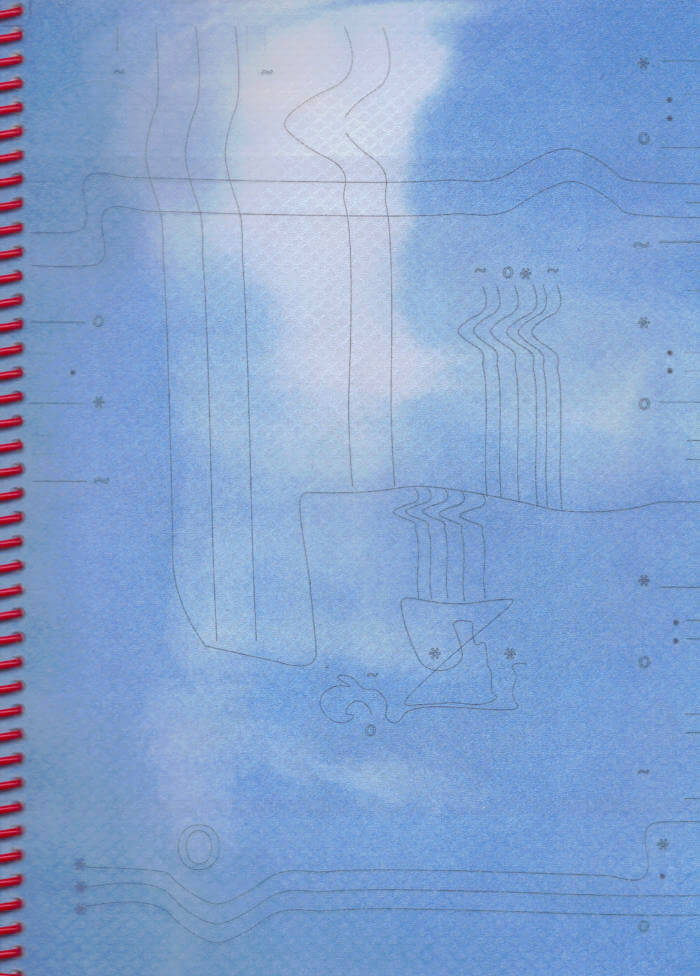
Under the Rainbow - Over the Weather
Speculative fiction magazine with contributions by 16 international (comic)artists/ writers/ designers/ curators/ witches. Exploring the world in the 4th millennium through images, words and dreamscapes.
Plastic coil bound with plastic covers.
Transparent cover with “A Short Manifesto” by Dutch conceptual artist Stanley Brouwn.
48 fold out pages, 185x262mm (foldes out to 185x365)
Riso printed on 100gr Munken Lynx by Hocus Bogus Publishing
Edition of 150
Cover design by Finn Melvin Caird
Design, layout and proofread by Yahaira Brito Morfe
Edited, printed and bound by Dennis Muñoz Espadiña
Language: English

SSaliva: Landscapes
‘Landscapes’ is a first attempt to highlight Ssaliva’s visual work. Through a selection of 100 images – digital paintings based on original photographs or screenshots – the book takes us on a scenic journey into the artist’s mind. Recalling a wide variety of references from the fields of photography, painting, landscape architecture and even Internet art, Ssaliva’s paintings bear witness to a wistful sensitivity to urban and rural exploration. Ssaliva has made his region a real playground. Walking through the “indeterminate” or empty spaces of Liège and its surroundings, the artist showed his empathy for the interstices and other abandoned places charged with history. This is what he tried to transcribe in the modification of his digital paintings: A veil wrapping his landscapes in mysteries. With this book, Ssaliva sets a coherent backdrop to his musical production, further completing the puzzle of an instinctive body of work inscribed in the pure romantic tradition.
"François Boulanger is an audiovisual artist born in Liège, Belgium in 1983. He started producing music by the end of the 90’s/early 2000’s and producing his visual work around 2010. Active under several monikers, he started his experimental project ‘Ssaliva’ in 2011 which today covers the entire spectrum of his works. Under this alias, he developed hypnotic soundscapes based on sparse rythms, lush tones and crystallised textures. A personal and romantic rendition of a life amidst nature and city pollution.
His work as Ssaliva also consists of documenting equally ethereal and removed places in pictures, two compulsive and lonely processes that have made him accumulate thousands of strange, escapist mental landscapes. His approach to visual arts is similar to music in terms of process too, stretching images and melodies, compressing bits of it, adding colors and samples until they become part of his own vision. Sometimes ghostly, sometimes sacred, an instantly recognizable form of melancholia.” — Munix
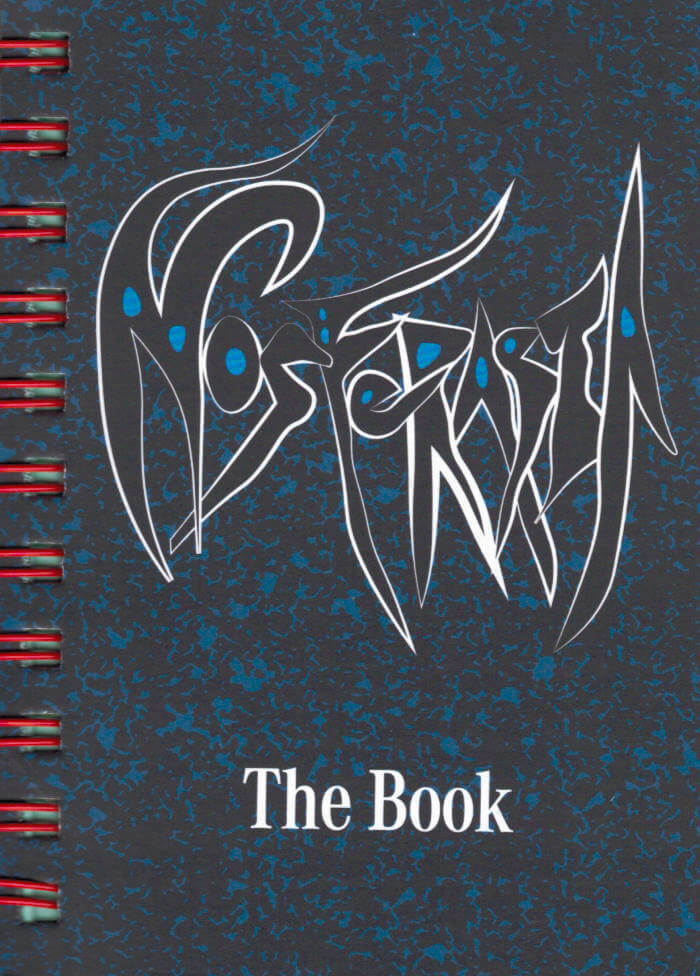
Nosferasta: The Book
Marking the first UK commission by Brooklyn-based filmmakers Adam Khalil and Bayley Sweitzer in collaboration with Oba, Gasworks has published a 176-page book that explores the ever-expanding vampiric universe of Nosferasta.
Spanning 500 years of colonial destruction, human trafficking and blood sucking, Nosferasta is a Rastafarian vampire film that reimagines Oba’s origin story in the late 15th century, when he is seduced by the vampire Christopher Columbus, ensuring his undying allegiance to the colonial project. Combining film forms and jumping across multiple timelines, Nosferasta examines the guilt of being complicit in imperial conquest, while acknowledging the extreme difficulty of unlearning centuries of vampiric conditioning. Ultimately, the film tackles an uncomfortable question:
How can you decolonise yourself, if it’s in your blood?
Interspersed with excerpts from Oba’s literacy diaries, Nosferasta: The Book features critical essays, speculative fiction and visual contributions by Peggy Ahwesh, Lou Cornum, Alex Esco, Sabel Gavaldon, Adam Khalil, Mutabaruka, Oba, Austin Sley Julian, Bayley Sweitzer, and Laura Vallés. Designed by fag tips (aka Virgil b/g Taylor).

Le Chauffage — Issue #2
Francesca Percival, Felix Rapp and 1 more
Le Chauffage (french for “The Heater”) is an artist-run publication based in Brussels and Vancouver. It is conceived as a cross-continental, community oriented platform. Le Chauffage brings together the work and writing of artists / friends from different cities with the intent to spark discussion and fuel casual forms of critical discourse.
The second issue of Le Chauffage contains photographs and texts, photographs of text, photographs as text and vice versa. Loosely thinking through the format of The Photo Essay celebrated by John Szarkowski in an eponymously titled exhibition at MoMA in 1965, this issue considers some of the artistic possibilities that can be found in such an archaic and historically male-dominated form.
Many of the contributions that make up this second issue are not photo essays per se. But each one of them considers the printed page as a space in its own right. The magazine becomes an interior where words and images entertain a malleable and distinctly porous relationship. At times, it is also a space where artists and writers from different cities were invited to meet and collaborate. And since interest in other people is also an interest in yourself, it is always unclear who is really transforming who?
Contributions by: Bob Cain & Linda Miller, Moyra Davey, Laurie Kang, Niklas Taleb, Madeleine Paré & Diane Severin Nguyen, Josephine Pryde, Slow Reading Club, Ken Lum, Isaac Thomas, Vijai Maia Patchineelam, Artun Alaska Arasli & Graeme Wahn, Stephen Waddell, Maya Beaudry & Chloe Chignell, Lisa Robertson, groana melendez, Victoria Antoinette Megens and Will Holder.
Editors: Emile Rubino and Felix Rapp
Co-Editor: Francesca Percival
Design: Francesca Percival and Felix Rapp
Cover Design: Francesca Percival
Printed by: Cassochrome, Belgium
Edition of 350

The Purple Line
The control of images, their authentication as facts, the possibility of making visible portions of reality removed from our gaze through pixelation–a technique in which the image becomes unrecognizable–are the central themes of the artist's research.
The cycle, created by recombining advertising photos alongside images of mutilated bodies, aims to stimulate a cultural and political reflection on the visual imagery of our contemporary world, on what is made public and what is concealed or censored. Hirschhorn overturns the selective logic with which images are normally shown: he pixelates capitalism, the consumerism to which visual culture is constantly subjected, and de-pixelates the most dramatic reality; he makes visible what comes to our eyes without mediation, and invisible or only partially visible what arrives artificial or filtered.
In addition to essays by the curators and international critics, the catalog includes an anthology of Thomas Hirschhorn's writings and an unpublished text. A section of the volume is dedicated to research materials and the sources used by the artist to create his works: paintings by other authors, advertising and reportage images, books, and short texts. The book is also accompanied by a rich iconographic apparatus that documents the installation views, and the images collected in the Catalog Raisonné, a complete documentation of the 122 Pixel-Collage.
Conceived entirely by the artist on the occasion of the homonymous solo exhibition at MAXXI, Rome, this volume documents Thomas Hirschhorn's research on Pixel-Collage, an impressive cycle of works realized between 2015 and 2017.
Edited by Hou Hanru and Luigia Lonardelli.
Texts by Thomas Hirschhorn, Hou Hanru, Luigia Lonardelli, Lisa Lee, Nataša Petrešin Bachelez, Yasmil Raymond, Dirk Snauwaert.